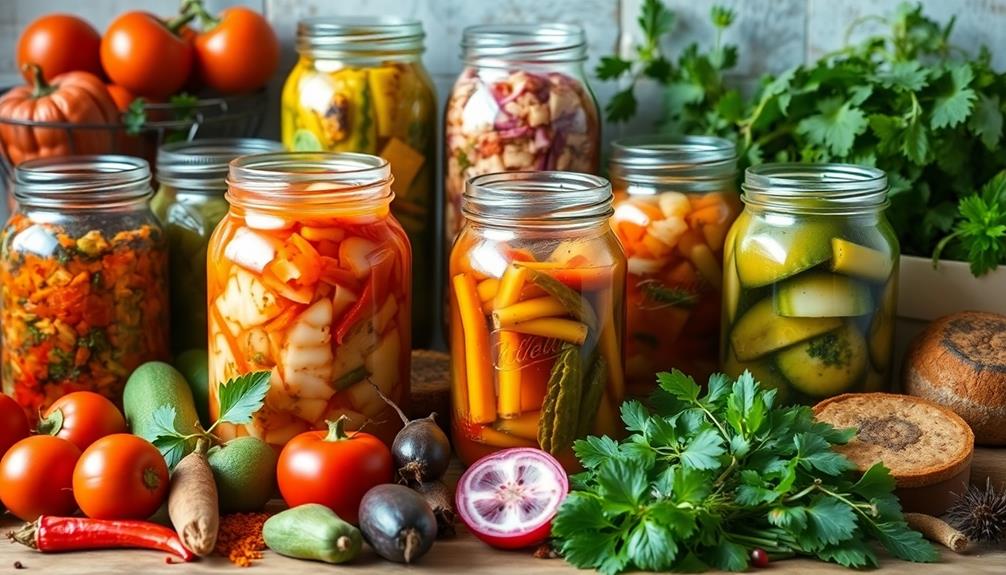Eating habits have a big impact on how well you sleep! To wake up feeling amazing, try these tips:
- Enjoy foods like turkey and dairy, which boost melatonin.
- Choose fruits, veggies, and whole grains for better rest.
- Avoid heavy meals, alcohol, and sugary snacks close to bedtime.
- Stick to regular meal times to help your body's sleep patterns.
Taking care of your tummy can lead to sweet dreams! You'll find that what you eat not only affects your sleep but also brings joyful days. Stick around to explore even more delicious ways to improve your zzzs!
Key Takeaways
- Healthy diets rich in complex carbohydrates, fruits, and lean proteins promote better sleep quality and reduce wakefulness.
- Foods high in tryptophan, like turkey and dairy, enhance melatonin production, aiding sleep.
- Late-night eating and irregular meal timing can disrupt circadian rhythms, leading to insomnia.
- High-fat, sugary, and spicy foods can cause digestive issues and disrupt sleep patterns.
- Consistent meal timing and nutrient-dense foods support overall sleep quality and faster sleep onset.
Nutrition's Role in Sleep Quality

Understanding how nutrition influences sleep quality can greatly improve your nightly rest. A healthy diet can make a big difference! If you're munching on foods high in saturated fats and sugars, you might find yourself waking up more often and struggling to feel rested.
Instead, focus on complex carbohydrates, fruits and vegetables, and lean proteins. These foods can help you sleep better! Incorporating foods rich in nutrients and flavors, like those found in Brazilian cuisine, can offer delicious options for a sleep-friendly diet.
Choosing foods rich in the amino acid tryptophan, like turkey and dairy, can boost melatonin production, which is essential for good sleep. If you've got insomnia symptoms or are at risk of obstructive sleep apnea (OSA), it's especially important to pay attention to your food choices.
Here are some tips for a sleep-friendly diet:
- Follow a Mediterranean diet, which is packed with healthy fats, whole grains, and plenty of fruits and veggies.
- Avoid late-night snacks, as irregular meal timing can mess with your sleep schedule.
- Stay hydrated, but limit drinks right before bed to avoid those pesky nighttime trips to the bathroom.
Making these changes can lead to a more restful night and brighter mornings! Sweet dreams await!
Foods That Enhance Sleep

When you're looking to improve your sleep quality, incorporating specific foods into your diet can make a significant difference.
Imagine snuggling up in your cozy bed after a good night's sleep, thanks to some delicious choices! For instance, enjoying a light meal of Mushroom Masala before bedtime can be both satisfying and beneficial, as the earthy flavors and spices create a comforting experience.
Here are some foods that can help you get those sweet dreams:
- Turkey and dairy: These are rich in tryptophan, which helps produce melatonin, the sleep hormone.
- Tart cherries and kiwi: Packed with melatonin and antioxidants, they can boost your sleep duration and quality.
- Whole grains: Foods like oatmeal and whole-grain bread help transport tryptophan to your brain, supporting serotonin and melatonin production.
- Fatty fish: Salmon and other fatty fish are loaded with omega-3 fatty acids and vitamin D, which can improve sleep quality and reduce disturbances.
- High-fiber foods: Fruits, veggies, and whole grains keep your gut healthy and stabilize blood sugar, preventing sleep disruptions.
Foods to Avoid for Better Sleep

To achieve better sleep, it's just as important to know which foods to avoid as it is to choose the right ones. Certain foods and beverages can really mess with your sleep quality. Here's a helpful guide for you!
| Food/Beverage | Why to Avoid Them | Better Alternatives |
|---|---|---|
| Alcohol | Disrupts REM sleep and increases awakenings | Water or herbal tea |
| High-fat foods | Can lead to digestion issues, reducing deep sleep | Lean proteins or veggies |
| Spicy foods | Can cause acid reflux and raise body temperature | Mild seasoning or bland foods |
| Sugary snacks | Causes energy spikes and crashes, disrupting sleep | Fresh fruits or nuts |
Diets low in fiber may also contribute to obstructive sleep apnea and other issues. So, steer clear of those sugary treats and heavy meals, especially close to bedtime. Remember, spicy foods can cause heartburn, making it tough for you to sleep peacefully. For good sleep quality, focus on the right dietary patterns to guarantee you wake up feeling refreshed and ready for the day!
Meal Timing and Sleep Patterns

Meal timing plays an essential role in your sleep quality, as irregular eating habits can throw off your body's natural circadian rhythms. When you eat at random times, it can disrupt sleep and lead to those pesky insomnia symptoms. To enjoy better sleep, try to stick to regular meal times. This helps your body know when it's time to eat and when it's time to sleep!
Incorporating nutrient-rich foods, such as those found in seasonal dishes like Nettle and Potato Soup, can further support your body's functions and promote restful sleep. These wholesome ingredients not only provide essential vitamins and minerals but also help regulate the body’s natural sleep-wake cycle by promoting the production of melatonin. Additionally, combining nutrient-dense meals with practices such as intermittent fasting can offer unexpected health benefits of fasting, including improved metabolism and reduced inflammation. This holistic approach to nutrition and timing of meals can significantly enhance overall well-being, fostering both physical and mental balance.
Late-night eating can be a real troublemaker. Meals too close to bedtime can cause discomfort and make your sleep patterns fragmented. You might find yourself tossing and turning instead of dreaming sweetly. Plus, late-night snacks can contribute to obesity, which can further mess with your quality sleep.
On the bright side, research shows that eating carbohydrates about four hours before sleep might help you fall asleep faster! So, if you want the best night's rest, aim for a healthy diet with meals spaced out throughout your day.
Strategies for Improved Sleep Quality

Improved sleep quality often hinges on the strategies you adopt in your daily routine. To help you sleep better, focus on enjoying a balanced diet filled with whole grains, fruits, and lean proteins. Incorporating foods rich in complex carbohydrates can also enhance your sleep quality, as they help produce serotonin, a precursor to melatonin.
For a delicious option, contemplate enjoying traditional Mexican dishes like Chilaquiles for breakfast, as they offer a satisfying combination of flavors and nutrients.
Here are some easy strategies to contemplate:
- Stick to Regular Meal Times: Eating at consistent times supports your circadian rhythms and helps you fall asleep faster.
- Choose Sleep-Promoting Foods: Incorporate tasty options like tart cherry juice, kiwi, and fatty fish into your meals. These can boost melatonin production and improve how long you sleep.
- Watch Your Dinner Choices: Avoid heavy, high-fat, or high-protein meals close to bedtime. They can cause digestive issues, making it tough to snooze comfortably.
- Limit Caffeine and Alcohol: Try to cut back on these, especially in the evening. They can disrupt your sleep cycles and leave you feeling tired the next day.
Frequently Asked Questions
Is There a Correlation Between Eating and Sleep?
Yes, there's a strong correlation between what you eat and how well you sleep. Your food choices, meal timing, and overall diet can greatly influence your sleep patterns, affecting both the duration and quality of your rest.
How Does Eating Too Much Affect Sleep?
Imagine a heavy boulder in your stomach, pressing down, making sleep elusive. If you eat too much, your body struggles to rest, leaving you tossing and turning, chasing elusive dreams, while fatigue lurks in the shadows.
Can Eating Too Little Affect Sleep?
Eating too little can definitely affect your sleep. Insufficient nutrients leave you hungry and restless, causing nighttime awakenings. Plus, a lack of key nutrients can disrupt your body's natural sleep rhythms, making rest elusive.
Does Eating at Night Affect Sleep Quality?
Imagine your body as a finely tuned orchestra; late-night eating can throw off the harmony. If you indulge too close to bedtime, you risk discordant sleep—fragmented and restless, leaving you weary for tomorrow's performance.
Conclusion
By choosing the right foods and timing your meals, you can open the door to better sleep! Just like a cozy bedtime story, the right nutrition wraps you in comfort and helps you drift off to dreamland. So, fill your plate with sleep-friendly goodies, steer clear of the sleep-stealers, and watch how your nights transform. Remember, a good night's sleep is like a secret gift waiting for you—unwrap it tonight! Sweet dreams await!










